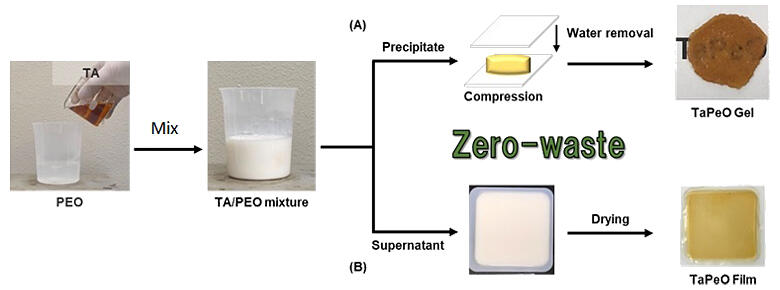A research group led by Associate Professor Taishi Higashi of the Faculty of Life Sciences, Yuika Goto (Graduate Student at the time of research) of the Graduate School of Pharmaceutical Sciences at Kumamoto University, and their colleagues has demonstrated that mixing tannic acid (TA) and ultrahigh molecular weight polyethylene glycol (PEO) in water produces a highly stretchable rubber-like gel (TaPeO gel). Under hydrated conditions, an elongation rate of up to 1000% can be achieved, and whereas the gel changes into a plastic-like material when dry. The broken surface could be reattached when immersed in hot water, indicating shape memory properties of the gel. Development of applications for the gel is expected. The results were published in the July 31 issue of the international academic journal Results in Materials.

Provided by Kumamoto University
Prior studies revealed that gels can be prepared from TA and polyethylene glycol (PEG). On this basis, the research group fabricated prototype gels using PEG of various molecular weights. They succeeded in preparing a gel with an ultrahigh molecular weight PEG (molecular weight of 500,000, denoted as PEO). The fabricated gel was completely different from the previously reported TA/PEG gel and was named as the TaPeO gel.
The TaPeO gel elongated well when pulled under moist conditions, exhibiting up to 1000% elongation. Additionally, drying of the TaPeO gel transformed it into a lightweight and tough plastic-like material. If the dried TaPeO gel was broken, it could be restored to its original shape by immersing the broken surface in hot water, followed by reattachment of the surfaces; this indicates the shape memory capability of the dried TaPeO gel. Furthermore, drying the unwanted supernatant generated during the preparation of the TaPeO gel resulted in a film with an elongation rate of more than 1500%, which is too high to be measured using the testing machine employed in this study.
It has been found that TA, which is present in tea, and PEO can be used to develop strong and intelligent gels and films with 'zero waste.' TA is an inexpensive, safe, and environmentally friendly material, and it has been reported to exhibit antimicrobial activity and antiviral activity against viruses, including the novel coronavirus. In the future, the research group plans to apply the fabricated material to medical and other materials.
Higashi commented, "A high-molecular weight PEG, which has never been investigated in our research field, was used in this study. It was accidentally purchased for another research project and was left in the laboratory. It was used as a trial, and a very unique gel was produced, leading to this discovery."
Journal Information
Publication: Results in Materials
Title: Zero-waste preparation of supramolecular hydrogels and films comprising tannic acid and ultra-high-molecular-weight polyethylene oxide
DOI: 10.1016/j.rinma.2023.100425
This article has been translated by JST with permission from The Science News Ltd. (https://sci-news.co.jp/). Unauthorized reproduction of the article and photographs is prohibited.




